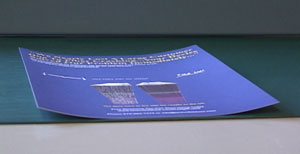When you run cover stocks on a buckle folding machine, you can end up with a curl that affects how well the job will run. Naturally, to get maximum benefit from your folder you want the ability to run as big a range of cover stocks and card stock as possible.
 The type of job we’re talking about here is one in which you run a single, unfolded sheet through the main, parallel section. It’s then creased, scored, or perforated before moving on to the right angle for folding or other operations.
The type of job we’re talking about here is one in which you run a single, unfolded sheet through the main, parallel section. It’s then creased, scored, or perforated before moving on to the right angle for folding or other operations.
A light curl is no big deal and in most cases you won’t even notice that the sheet picked up a curl as it ran through the parallel section. But as the curl gets more pronounced, you’ll run into problems. For instance, a curled sheet might not enter the right angle side guide. Or it could prevent the sheet from entering the fold roller in the next section. It could even contribute to nicking at the lead edge of the sheet if you’re scoring or perfing.
The severity of curl is affected by a few factors.
- First is the thickness of the paper. Heavier paper will retain a curl more than a thinner sheet. Also, when you reach your folding machine’s limit regarding paper thickness, you’ll know it. You start to get the alligator skin effect in which the entire surface has wrinkles all over it.
- Next is the diameter of the fold rollers. Smaller diameter means more curl.
- Grain direction also has an effect. Long grain, parallel to the fold rollers, will curl a bit more than the opposite grain.
The good news is that there’s a fast and easy way to minimize or prevent curl, even on very heavy sheets. We show you how to do that in the short video below. This technique will also get rid of alligator skin.
I’ve been able to run some pretty thick cover and card stocks like this, and still maintain good register. Of course there are still limitations; you can’t run just anything. But if you haven’t tried this trick, you might be surprised to find out how many more jobs you can perform on your folding machine, on stock that is heavier than you thought possible.
For the every-day cover stocks found in a commercial printing or quick-copy environment, this technique should easily eliminate any curl problems and improve consistency in register.
Although this tip is geared towards floor model folding machines, you tabletop folding machine operators might be able to modify this idea to work on your machines. Could be a topic for a future bindery video!
Click the video below to watch.

